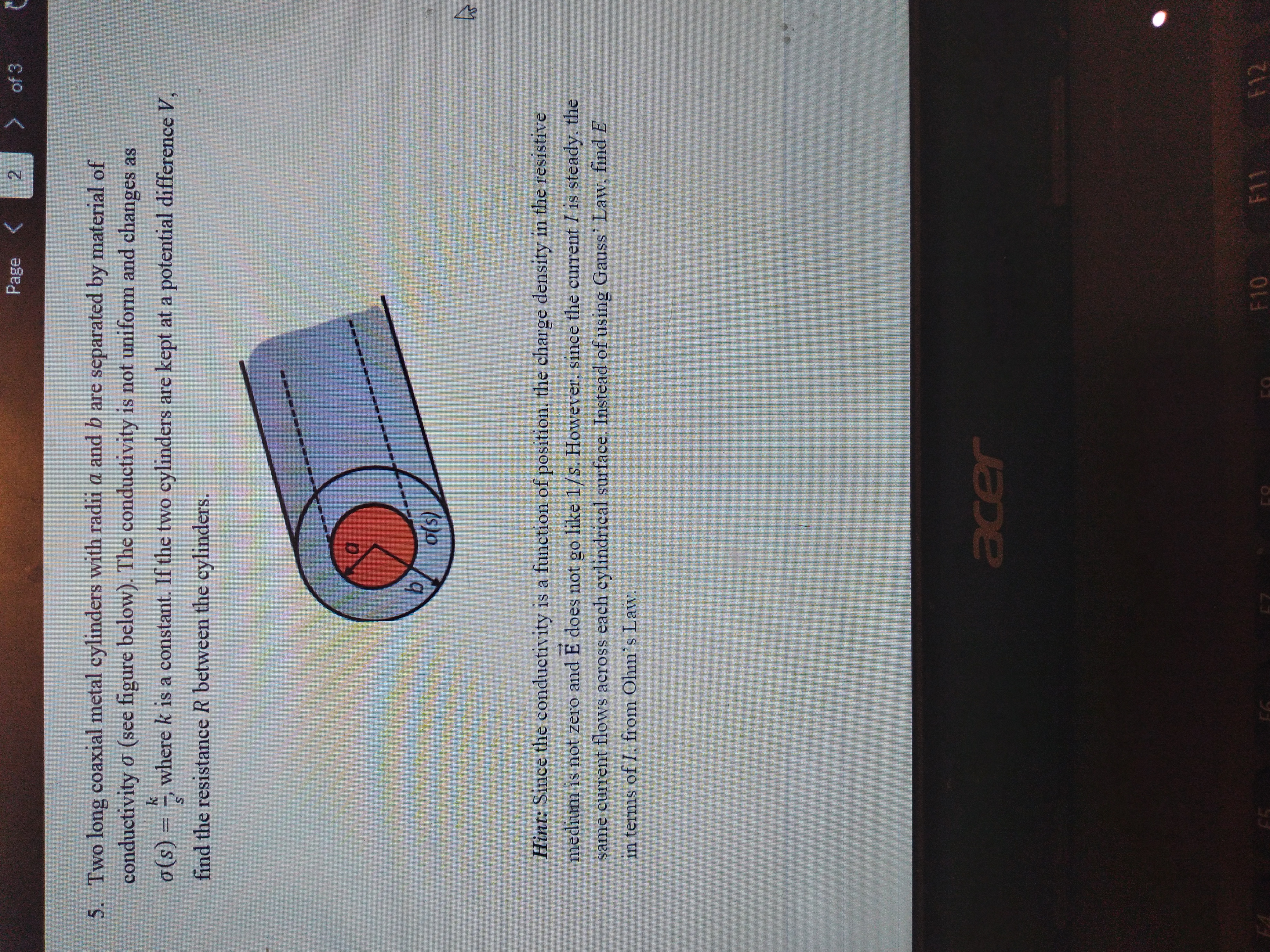Question

Transcribed Image Text:2.
Page
> of 3
5. Two long coaxial metal cylinders with radii a and b are separated by material of
conductivity o (see figure below). The conductivity is not uniform and changes as
= (s)0
where k is a constant. If the two cylinders are kept at a potential difference V,
find the resistance R between the cylinders.
(s)o
Hint: Since the conductivity is a function of position, the charge density in the resistive
medium is not zero and E does not go like 1/s. However, since the current I is steady, the
same current flows across each eylindrical surface. Instead of using Gauss' Law, find E
in terms of I, from Ohm's Law.
acer
F10
F11
Expert Solution
This question has been solved!
Explore an expertly crafted, step-by-step solution for a thorough understanding of key concepts.
This is a popular solution
Trending nowThis is a popular solution!
Step by stepSolved in 6 steps

Knowledge Booster
Similar questions
- Question 1, part (a) ... Three resistors (shown below) are all made out of the same material with the same resistivity p, but they all have different spatial dimensions. Which resistor has the largest resistance? L/2 – L Area 2A- Resistor B Area A Resistor A 2L Area A/2 Resistor C Select an answer and submit. For keyboard navigation, use the up/down arrow keys to select an answer. a Resistor A b Resistor B C Resistor Carrow_forwardSuppose you wish to fabricate a uniform wire from 1.60 g of copper. The wire is to have a resistance of R = 0.800 2 and all the copper is to be used. (a) What must be the length of this wire? m (b) What must be the diameter of this wire? μmarrow_forwardA 22 Ω resistor and a 4 Ω resistor are connected in series to an ideal 12 V battery.Find the current in each resistor.Answer in units of A.Find the potential difference across the firstresistor.Answer in units of V.Find the potential difference across the secondresistor.Answer in units of V.arrow_forward
- (a) What is the resistivity of the wire? (b) What material is the wire made of? You will have to look up the various resistivities.arrow_forwardTo what value would you have to raise the temperature of a copper wire (originally at 20 °C) to increase its resistance by 18 % ? Assume the temperature coefficient of resistivity of copper is 0.0039 (°C) 1. Express your answer using two significant figures. ? Tinal = °C Submit Request Answerarrow_forwardQuestion A2 Pure copper has a resistivity of 1.68 x 10-8 Nm. Some accurate cubes of copper are prepared, and electrical measurements are made, for which current is passed across a pair of opposite faces. a) Comparing a 2.5 cm cube and a 5 cm cube, which will have the higher conductance? Ex- plain your answer. b) Given eight 1 cm cubes, how can they be stacked to get the highest and the lowest resis- tance between opposite faces of the stack? Calculate the resistance of each stack.arrow_forward
- are made of the same metal. 7) wires 1 and 2 wire 2 has twice the length and twice the diameter of wire 1. What are the ratios (a) Q₂/Q² of the resistivities and (b) R.2/121 of the resistance of the two wires? A) P₁/P₁ = 1, 1₂/1²₁=0.5 13) P₂/p₁ = 1, 82₂/124₁ =0.25 C) P₁/P₁ = 0.5² h₂/1²₁=0.5 D) P₁/P₁ = 0.25, 1₂₁/1²₁=0.5 2 रarrow_forwardProblem 2: The battery has a potential difference of 10 V and each resistor has a resistance of 2 ohms. RI R2 'R3 (a) Determine the equivalent resistance of the 3 resistors. (i.e. if you replace the three resistors shown with a single equivalent resistor, what value should you select?) 3 ohms (b) Determine the current through each resistor. (R1 has 1.66 A, R2 has 1.66 A, R3 has 3.33A)arrow_forwardWire B has twice the length and twice the radius of wire A. Both wires are made from the same material. If wire A has a resistance R, what is the resistance of wire B?arrow_forward
arrow_back_ios
arrow_forward_ios